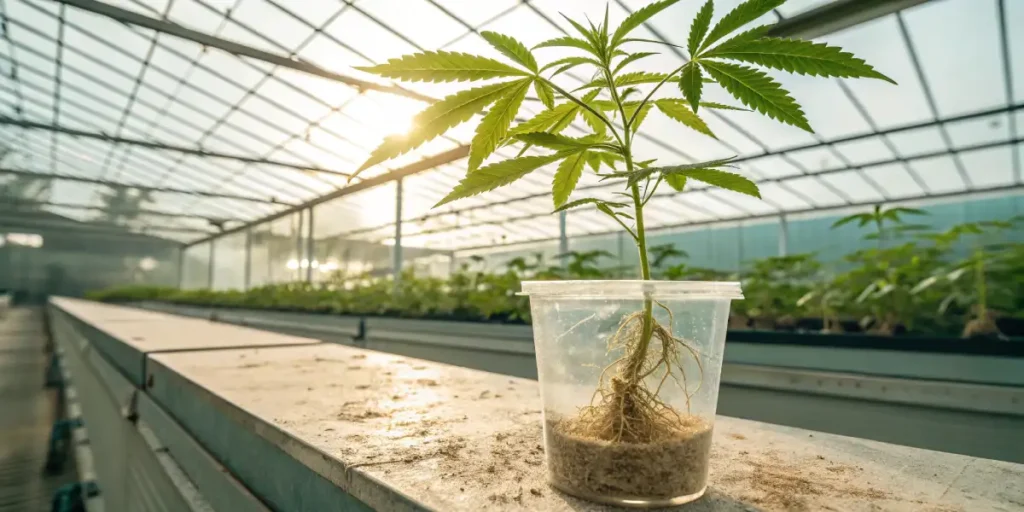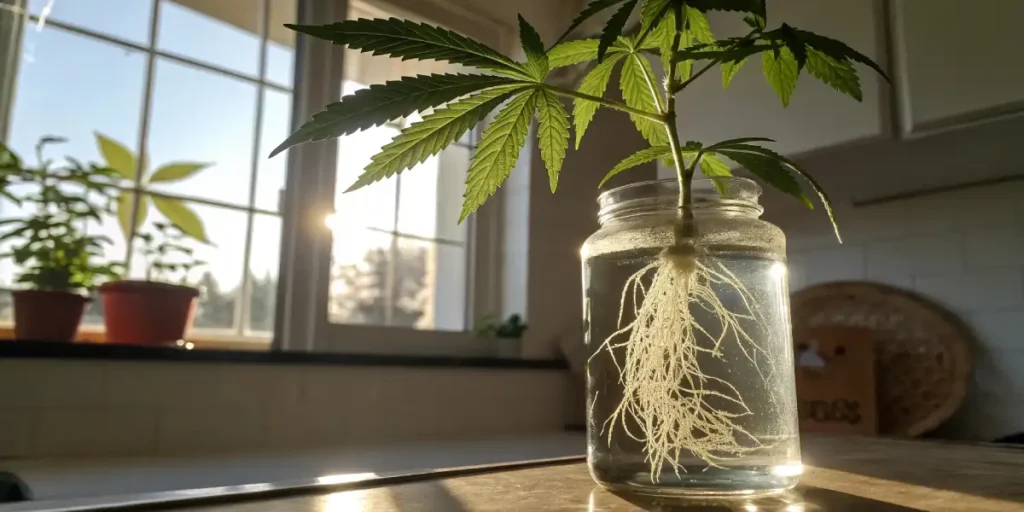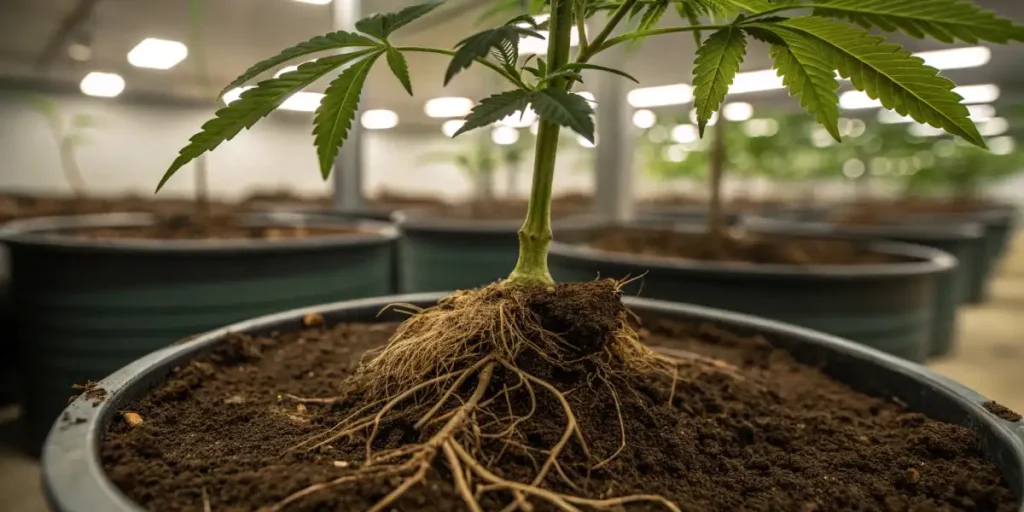
Cannabis Fuzzy Roots: Identification, Causes, and Treatment
Fuzzy roots are usually healthy plant root hairs fine, white, hair-like structures that increase the root’s surface area for absorbing water and nutrients, helping to anchor the plant securely in the soil. These fuzzy roots are a normal sign of a thriving, growing plant and should not be mistaken for mold, which has a more web-like and irregular pattern. Often appearing on water-propagated cuttings, fuzzy roots can also indicate unique plant adaptations, such as the velvety, moisture-retaining roots found in certain orchids. Understanding fuzzy roots is essential for plant enthusiasts who want to recognize healthy growth and prevent unnecessary concern about mold or disease.
“Fuzzy marijuana” is often a sign of mold or mildew forming on cannabis buds, rather than the plant’s natural trichomes responsible for its sticky, resin-rich texture. This kind of contamination usually appears as a whitish or gray, fuzzy or powdery layer on the surface, sometimes accompanied by dark patches.
Recommended Strains
Acid Diesel
|
|
THC | 18% - 20% (Medium) |
|
|
Type | Feminized |
|
|
Yield | Low |
|
|
Phenotype | 60% Indica / 40% Sativa |
Afghan Kush
|
|
THC | 16% - 21% (Medium) |
|
|
Type | Feminized |
|
|
Yield | Medium |
|
|
Phenotype | 90% Indica / 10% Sativa |
Have you ever noticed a fluffy, fuzzy appearance on the roots of your cannabis plants? These are known as cannabis fuzzy roots. While they might seem harmless, they can indicate underlying health issues. This guide will help you navigate the world of fuzzy roots and ensure your cannabis plants thrive.
Identifying fuzzy roots is crucial. These roots often appear white or off-white and have a cotton-like texture. They may seem like a sign of vigorous root growth, but more often than not, they signal a problem. Fuzzy roots can significantly impact nutrient absorption and water uptake.
What Causes Fuzzy Roots in Cannabis Plants?
Fuzzy roots in cannabis plants can result from several factors. One common cause is fungal infections in overwatered or poorly drained growing mediums. Another factor could be nutrient imbalances, which can stress the roots.
Environmental conditions also play a significant role. High humidity levels, inadequate airflow, and insufficient light can contribute to an environment where fungi thrive. Specifically, high temperatures in the grow space and within the pots can create a stressful environment that encourages this problem. Furthermore, the quality of your irrigation water is a major factor. Water that is too warm (ideally, it should be around 18°C or 65°F) or water that is stagnant and lacks oxygen can also contribute to the appearance of fuzzy roots.
Moreover, the type of growing medium used can influence the occurrence of fuzzy roots. Soil that retains too much moisture can lead to root rot and fungal infections.
Fungal Infections and Cannabis Fuzzy Roots
Fungi thrive in warm, moist environments, and overwatering is a leading cause. Preventing fungal infections involves managing your watering schedule carefully and ensuring the medium dries out between waterings. Regular cleaning and sterilization of growing equipment can also help reduce the risk. Incorporating natural antifungal treatments, such as neem oil, can be beneficial.
Promos & Deals
How to Treat Fuzzy Roots in Cannabis Plants
Once you’ve identified fuzzy roots, it’s crucial to act promptly. Treatment often involves addressing the underlying cause. One effective method is using beneficial microbes to outcompete harmful fungi. These products, like mycorrhizal inoculants, can protect your roots and enhance nutrient uptake.
Another advanced treatment method involves adjusting your water’s pH. If you detect fuzzy roots, some growers recommend watering with a solution that has a slightly lower pH than usual, around 5.5. This can help to correct potential nutrient lockout issues and make the root zone less hospitable to certain types of fungi.
For severe cases, it may be necessary to prune away the affected roots. Gently trimming back the damaged roots can prevent the spread of infection. Ensure your tools are sterilized. Reassessing and adjusting environmental conditions is also important for recovery.

Improving Drainage and Aeration
Improving drainage and aeration is essential. A simple and highly effective preventative measure is to place a layer of gravel or clay pebbles at the bottom of your pots before adding soil. This creates an excellent drainage layer that helps prevent water from stagnating and ensures the drainage holes don’t get clogged by roots, which is a primary cause of fungus and fuzzy roots. If you’re using soil, consider adding perlite or vermiculite to increase aeration. Using raised beds or fabric pots can further enhance drainage.
Beneficial Microbial Applications
Applying beneficial microbes can be a game-changer. Mycorrhizal fungi form symbiotic relationships with roots, enhancing nutrient and water uptake and making the plant more resistant to pathogens. Products containing Trichoderma or Bacillus species can also enhance the soil microbiome and suppress pathogenic organisms.
Cannabis Fuzzy Roots Prevention Tips
Prevention is always better than cure. Start by maintaining optimal growing conditions. Choose cannabis strains that are resilient and known for their robust root systems, like Sour Diesel, Bruce Banner #3, and Girl Scout Cookies.
Another excellent preventative technique is to protect the topsoil with a layer of mulch. Using materials like bark chips, cork, or moss to cover the soil helps regulate moisture and temperature at the surface, making the environment less favorable for the development of root problems.
Developing a comprehensive prevention plan involves regular monitoring and adjustments. A healthy growing environment is the best defense against potential issues.
Proper Watering Techniques for Healthy Roots
Watering is an art. Too much water can suffocate roots, while too little can dehydrate them. Aim for a “wet-dry” cycle, allowing the top inch of soil to dry out before watering again. This prevents fungal growth and encourages roots to search for moisture, promoting healthy development.
Use pots with adequate drainage and avoid letting plants sit in excess water. Adjust your watering schedule based on the plant’s growth stage and environmental conditions. For instance, plants in flowering may require more frequent watering than those in the vegetative stage.
Implementing automated irrigation systems can help manage watering schedules more precisely, reducing the risk of overwatering or underwatering. These systems can be tailored to the specific needs of your plants, ensuring consistent moisture levels and preventing cannabis fuzzy roots.
Additionally, using water sensors or moisture meters can provide real-time feedback on soil moisture content. These tools allow for more informed decisions about when and how much to water, further optimizing root health and preventing the conditions that lead to fuzzy roots.
Choosing the Right Strains for Strong Roots
Choosing the right cannabis strain is crucial for preventing fuzzy roots. Some strains are naturally more resistant to root diseases and environmental stressors. Strains like Sour Diesel, Bruce Banner, and Girl Scout Cookies offer strong genetics that can withstand common cultivation challenges.
When selecting seeds, look for those that are bred for resilience and high yield. Blimburn Seeds offers a wide variety of such strains. These strains not only produce potent buds but also ensure robust root systems that resist fuzzy root issues.
Researching the genetic background and growing requirements of different strains can provide insights into their resilience. Selecting strains with a history of thriving in similar conditions to your growing environment can enhance their ability to resist cannabis fuzzy roots.
Additionally, consider experimenting with different strains in small batches to determine which perform best in your specific setup. This trial-and-error approach can help identify the most suitable strains for your conditions, leading to healthier plants and reduced risk of root issues.

FAQs
What are cannabis fuzzy roots?
Cannabis fuzzy roots appear as white, cotton-like growths on the roots of cannabis plants. They are often caused by fungal infections or nutrient imbalances. While they might seem harmless, they can signal underlying health issues that need to be addressed.
Fuzzy roots can affect the plant’s ability to absorb nutrients and water, leading to stunted growth and poor yields. Identifying and treating them early is crucial to maintaining healthy plants. Regular inspections and preventative measures can help keep these issues at bay.
Root identification is key to effective management. Early detection through regular check-ups can prevent the escalation of issues, ensuring that plants remain vigorous and productive throughout their growth cycle.
Moreover, educating yourself on the specific signs and symptoms associated with fuzzy roots can enhance your ability to respond promptly. This proactive approach can safeguard your cannabis crop, leading to healthier plants and improved yields.
How can I identify fuzzy roots in my cannabis plants?
Identifying this issue is relatively straightforward. Look for white, fluffy growths on the root system. These may be more prevalent in overwatered or poorly aerated conditions. Other signs include wilting, yellowing leaves, and reduced vigor.
If you suspect fuzzy roots, gently remove the plant from its pot and inspect the root ball. Healthy roots should be firm and white, while fuzzy roots will have a distinct, cotton-like appearance. Early detection allows for more effective treatment and management.
Regular root inspections should become an integral part of your cultivation routine. By making these checks systematic, you can catch potential issues before they develop into more serious problems, ensuring the overall health of your cannabis plants.
Additionally, keeping detailed records of any symptoms observed and actions taken can help refine your cultivation practices over time. This data-driven approach can enhance your ability to manage and prevent cannabis fuzzy roots effectively.
How do I treat fuzzy roots in cannabis plants?
Treating fuzzy roots involves addressing the root cause. If it’s a fungal issue, consider applying beneficial microbes that can outcompete harmful fungi. Improve drainage and aeration in your growing medium to prevent future issues.
Address nutrient imbalances by performing a soil test and adjusting your feeding schedule. Use balanced fertilizers and avoid over-fertilizing. Consistent monitoring and adjustments can help restore root health and prevent recurrence.
In severe cases, it might be necessary to repot the plant into fresh, well-aerated soil. This can help eliminate the conditions that foster fuzzy root development, giving your plant a fresh start and the opportunity to recover.
Knowing how to treat fuzzy roots in cannabis plants is crucial for maintaining a healthy garden. Through a combination of targeted interventions and ongoing care, growers can overcome these challenges and support robust plant growth.
What are the best prevention tips for cannabis fuzzy roots?
Prevention starts with maintaining optimal growing conditions. Ensure proper watering techniques, nutrient management, and environmental control. Allow the growing medium to dry out between waterings to prevent fungal growth.
Choose resilient cannabis strains with robust root systems. Strains like Sour Diesel, Bruce Banner 3, and Girl Scout Cookies from Blimburn Seeds are excellent choices. These strains are known for their strong genetics and resistance to common root problems.
Implementing a proactive maintenance schedule can also aid in preventing root issues. Regularly cleaning and sterilizing equipment, as well as monitoring environmental changes, can create a stable environment that discourages problems.
Furthermore, continuous education on new cultivation techniques and products can provide additional tools and strategies to keep roots healthy, ensuring that your plants thrive in any growing conditions.
Can fuzzy roots affect the overall health of my cannabis plants?
Yes, fuzzy roots can significantly impact the overall health of your cannabis plants. They can hinder nutrient and water absorption, leading to stunted growth, wilting, and poor yields. Addressing the issue promptly is essential to prevent further damage.
By maintaining a healthy root system, you ensure your plants can absorb the nutrients and water they need to thrive. Regular inspections and preventative measures can help you catch and correct issues early, promoting a healthy and productive cultivation.
The impact of cannabis fuzzy roots extends beyond immediate symptoms, potentially affecting the plant’s long-term resilience and productivity. Ensuring robust root health is foundational to successful cannabis cultivation.
By fostering an environment that supports healthy root development and actively preventing issues, growers can maximize their yields and enhance the overall quality of their cannabis plants, leading to a more successful harvest.




















